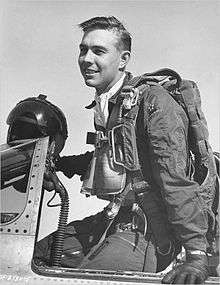Harold Fischer
| Harold Edward Fischer | |
|---|---|
 Harold Fischer in Korea | |
| Nickname(s) | Hal |
| Born |
May 8, 1925 Lone Rock, Iowa |
| Died |
April 30, 2009 (aged 83) Las Vegas, Nevada |
| Buried | Arlington National Cemetery |
| Allegiance | United States |
| Service/ |
United States Navy United States Air Force |
| Years of service |
1943–1944 1949–1978 |
| Rank | Colonel |
| Battles/wars |
World War II Korean War Vietnam War |
| Awards |
Distinguished Service Cross Silver Star Legion of Merit Distinguished Flying Cross (2) Meritorious Service Medal Air Medal (8) |
Colonel Harold Edward Fischer, Jr. (May 8, 1925 – April 30, 2009)[1] was a United States Air Force fighter pilot and flying ace of the Korean War.
Early life
Fischer was born near Lone Rock, Iowa, in a farm on May 8, 1925.
Military service
After service with the United States Navy in World War II, followed by service with the United States Army, Fisher transferred into the United States Air Force in 1949.
Serving with the 39th Flying Training Squadron, Fischer saw action in the Korean War, shooting down eleven MiG aircraft in his more than 175 combat missions. On April 7, 1953, he was shot down and ejected from his F-86 Sabre north of the Yalu River, in a dogfight with three MiGs that extended into Chinese territory, an area that the Air Force had specifically ordered its pilots not to enter.[2] Contrary to these facts, the Soviets did not admit their operations alongside the Chinese in the Korean War, and dispute the consideration that a Chinese pilot had shot down Fisher.[3] The retired Colonel Harold Fisher would meet Han Decai again, and become friends, gifting Han Decai with a model of an F-86 Sabre Jet.[4]
Fischer was taken captive by Chinese military personnel and imprisoned near Shenyang, Liaoning Province. Although the Korean Armistice Agreement called for the release of all prisoners of war, Fisher was not freed. After a thwarted escape attempt nine months into his captivity, he was routinely tortured and ultimately admitted to trumped up charges that he had been ordered to enter Manchuria and that he had participated in germ warfare.[5]
A mock trial led to his release in May 1955. Fischer was returned to active service two months later.
He also served in the Vietnam War, mainly as a helicopter pilot. He flew more than 200 missions over South Vietnam.
Fisher served for a full 30 years, receiving many decorations, including the Silver Star, the Distinguished Flying Cross, and the Distinguished Service Cross.
Later life
Fischer died on April 30, 2009, in Las Vegas, Nevada, from complications after back surgery. He was 83. He is buried at Arlington National Cemetery in Section 59.
References
- ↑ Hevesi, Dennis (May 8, 2009). "Harold E. Fischer Jr., an American Flier Tortured in a Chinese Prison, Dies at 83". The New York Times. Retrieved May 8, 2009.
- ↑ "Interview with Harold E. Fischer: Korean War Jet Ace and POW". historynet.com. January 16, 2007. Retrieved July 5, 2016.
- ↑ Сейдов, Игорь (2007). "Красные дьяволы в небе Кореи". Archived from the original on February 24, 2012. Retrieved July 10, 2012.
- ↑ Davis, Rebekah (May 25, 2009). "Harold E. Fischer Jr. dies at 83; Korean War ace". Los Angeles Times. Retrieved July 5, 2016.
- ↑ Davis, Rebekah (May 10, 2009). "Col. Harold E. Fischer Jr., 83". Washington Post. Retrieved 1 November 2016.
External links
| Wikimedia Commons has media related to Harold Fischer. |
- Harold E. Fischer Personal Papers SDASM.SC.10047 .O/S, San Diego Air and Space Museum Library and Archives
- Harold E. Fisher, Jr. (Photo Collection), Flickr, San Diego Air and Space Museum Archives